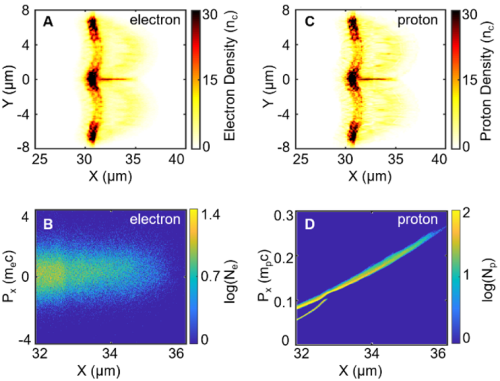The researchers in the State Key Laboratory of High-Field Laser Physics at the Shanghai Institute of Optics and Fine Mechanics (SIOM) of the Chinese Academy of Sciences (CAS) have made progress in high-efficiency plasma beam self-collimation mechanism by ultra-intense vortex lasers. The corresponding paper of "Topological structure effects of Laguerre-Gaussian laser on self-collimation acceleration mechanism" was published on Frontiers in Physics on December 15, 2022.
The interaction of ultra-intense lasers with solid target plasmas can produce a large number of high-energy particles, which can be potentially applied for fast ignition in inertial confinement fusion, ultrafast imaging, proton therapy, and theoretical studies of astrophysical jet mechanisms. These particle beams important for application, which are required to be highly collimated.
Here, the researching team proposes a mechanism for generating self-collimating particle beams driven by a Laguerre-Gaussian (LG) laser. Under the interaction between Laguerre-Gaussian laser and target, the ponderomotive force acts on the particles and pushes them inward, colliding on the central axis to form a collimated particle beam with a radius of 100 nm. At the same time, the beam current generates an ultra-strong toroidal magnetic field channel to further maintain the particle beam there.
In addition, a higher topological charge of the LG laser can further enhance the beam collimation and improve the efficiency of the potential applications, such as fast ignition in inertial confinement fusion and proton therapy.

FIGURE 1. Profiles of LG laser intensities with topological l = 1, 2, and 3. The radius w1, w2, and w3 correspond to the maximum light fields for the topological charge of l = 1, 2, and 3. (Image by SIOM)

FIGURE 2. Density distribution of (A) the electrons and (B) the protons at t = 80TL. Phase spaces of (C) the electrons and (D) protons in the region (r ≤ 0.2 μm, 32 μm < x < 34 μm). (Image by SIOM)
Article website:
https://doi.org/10.3389/fphy.2022.1054778
Contact:
WU Xiufeng
General Administrative Office
Shanghai Institute of Optics and Fine Mechanics, CAS
Email: xfwu@siom.ac.cn
Web: http://english.siom.cas.cn/